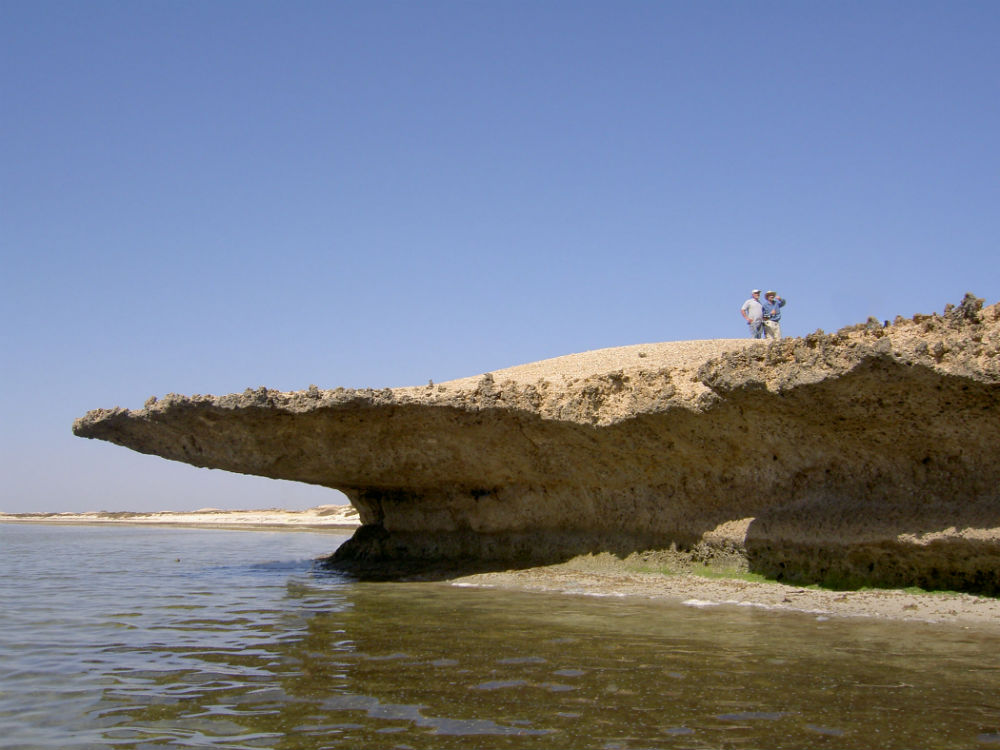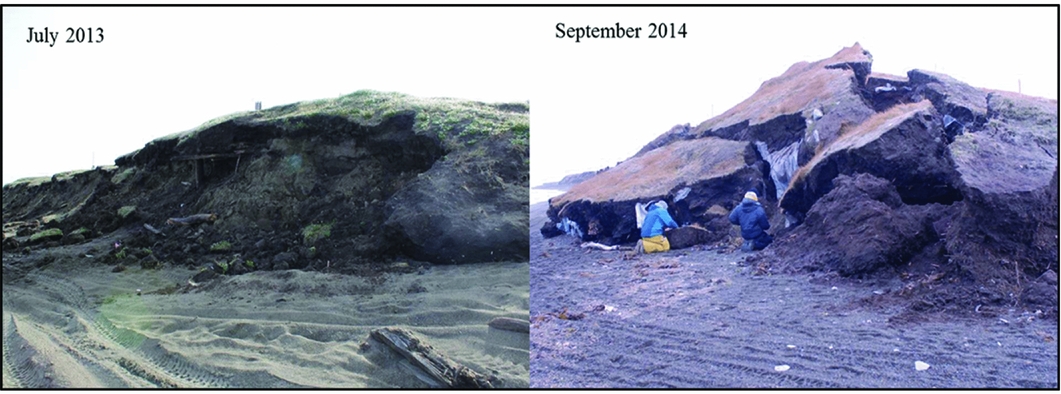
If you like clams, you’re not alone. For the past 164,000 years, people have used shellfish as a food source. We know this thanks to shell middens found on shorelines around the world. By studying these mounds, scientists can say a lot about the history of early humans — from their dietary preferences to migration paths.
But this window into humankind’s past is shutting down because of — you guessed it — climate change. Rising sea levels, thawing permafrost, and vegetation increases are destroying archeological sites everywhere.
The latest findings come from scientists studying over 3,000 prehistoric shell midden sites on the Farasan Islands in the Red Sea some 30 miles offshore from Saudi Arabia. For 7,500 years, these sites have experienced a naturally fluctuating shoreline, giving the research team a perfect opportunity to assess the effects of such changes. Usually well-preserved at archaeological sites, shells are now being washed away by rising sea levels.
And sea-level rise could be having an even greater impact on the archaeological record in the Arctic. Last year, scientists studied national cultural heritage databases and determined at least 180,000 archeological sites in the Arctic. These sites are being lost to climate change faster than sites elsewhere, according to the paper published in the Antiquity journal.
Among endangered sites are Paleolithic excavations in the lower reaches of the Yana River in eastern Russia that show the life of ancient humans who settled the Arctic about 30,000 years ago. Ivory was found there with carved patterns that gave a glimpse of early Siberians’ symbolic and ritual activities. Today, the Yana site is facing the threat of destruction — part of it was already washed away due to erosion.
Even increased vegetation caused by a warmer climate threatens heritage sites. As boreal forests expand into the Arctic tundra, roots exploit the soil for water and nutrients — it could cause physical damage to organic archaeological material and disturb the archaeological stratigraphy, which is crucial to site interpretations.
And there are problems in the continental U.S., too. Scientists announced in a 2017 study that almost 20,000 recorded archaeological sites along the coastline from Maryland to Louisiana are in danger of being destroyed by a sea-level rise of only 3 feet.
One of the endangered sites is Fort Sumter, where the first shots of the Civil War were fired. The low-elevation island it’s located on would be lost by 3 feet of sea-level rise. Even the Lincoln and Jefferson memorials in Washington, D.C., are at risk because the Potomac River would experience higher tides and more frequent flooding due to climate change.

Examples from Walakpa in Alaska of newly exposed archaeological layers that are quickly degrading due to multiple processes: permafrost thaw, frost/thaw processes, microbial degradation and wave action during storms.
In a weird twist, the same thing that threatens world heritage also can help uncover it. Since the 1990s, the discoveries include Viking artifacts in Norway, ancient weapons in Canada, and human remains in South America. For years scientists didn’t consider sub-Arctic areas as places worth digging, but ice and permafrost created a perfect environment for preserving organic materials of ancient nomadic civilizations. Until, of course, climate change struck.
I’ve asked the scientists how climate change threatens archeological sites and how to protect world heritage. These are their answers:
Matthew Meredith-Williams, archaeologist at the La Trobe University, Australia:
— Our research both demonstrates and quantifies how sea-level change in the past has nearly erased an episode of coastal exploitation from the archaeological record. Without taking a combined approach — at the broad-scale identifying groups of sites and an in-depth analysis of a sample of these groups — we would not have been able to disentangle that these groups are actually what remains of several superimposed episodes of activity, where the earliest episode of coastal exploitation had nearly been erased by past sea-level rise. Using the most recent episode as an analogy for the earliest episode, we have quantified the serious impact of past sea-level rise.
The problem of rising sea levels is a global problem, which is only forecast to get worse. Whilst there are many very negative connotations with sea-level rise for a global society in general, the issue has severe impacts on cultural heritage worldwide.
The sites on the Farasan are clearly at risk; however, the impacts of global sea-level rise have implications globally. There are several well-documented examples of exposed coastal sites being damaged or lost to sea-level rise. However, the universal risk to coastal archaeology from sea level rise is clear. If we fail to address this issue, virtually all coastal sites will be impacted — both those we know about and many more that have not yet be found and likely never will be before they are destroyed.
Sara Gonzalez, anthropologist at the University of Washington:
— When we think of climate change, it’s often abstracted as this external phenomenon. Yet, changes in average temperature, annual and seasonal rainfall, and weather patterns have very specific impacts on the degree to which archaeological sites, or ancestral places, are preserved in the ground. For sites along the Pacific Coast, rising sea water and the intensity of storms create the threat of inundation and rapid coastal erosion, which threatens to destroy many significant coastal sites from Baja up to the Alaskan seashore.
In Scotland, for example, civic scientists have partnered with archaeologists to document and record rising sea levels near local archaeological sites. With this data, research teams are working to identify which sites are imminent danger of being lost to the sea.
Sites located in regions with permafrost are unique in that the stable, freezing temperatures create the perfect condition for preservation. But as the permafrost and underlying ice melt, the cultural belongings — and associated knowledge — begin to rapidly decompose while the melt creates the potential for large areas of sites to collapse.
In Washington, Oregon, and California, sites are not only being impacted by coastal erosion, and rising sea levels, the increase in large, catastrophic fires is also creating significant dangers for tribal and other heritage. While belongings and features may be buried below ground, a large fire event destroys evidence contained in the dirt itself: traces of past plants, records of past soil temperature, and other information is also destroyed, thus eliminating key lines of evidence we can use to understand better what a place and its environment looked like from the deep past to recent memory.
The single biggest thing we can do to protect archaeological sites and tribal heritage is to build partnerships with tribal nations. In working together, there is potential to think creatively about how both indigenous and archaeological approaches may be used to care for and protect ancestral places threatened by climate change.
While we may use techniques such as full-scale excavation of ancestral places as a strategy to preserve cultural belongings that are eroding out of coastal sites or threatened by inundation or the thawing of permafrost, this comes at a steep cost: physical destruction of an ancestral place and the removal of belongings from their intended resting places. In some cases, a tribal nation may not prefer to use this approach as the active disturbance of ancestral places. Alternative strategies such as capping a site with materials designed to delay erosion may be preferred.
In another context, a community may decide that allowing the natural course of action (erosion or decomposition) is appropriate. It allows for belongings left in place to become part of the earth again. Yet in others, communities may choose instead to pursue a combination of archaeological methods, including excavation or other less-impactful techniques such as Ground Penetrating Radar or LiDAR (survey techniques designed to provide snapshots of surface and below-surface remains) to recover and preserve information about a place. In these cases, the potential to remember tribal history through archaeology may respond to specific needs within the community.
Indeed, in my own work with the Confederated Tribes of Grand Ronde Community of Oregon, I’ve worked with tribal heritage monitors to study ancestral places on their reservation. While the tribe had reservations about the disturbance of ancestral places, we have developed a low-impact approach that maximizes the information we can gain from a place while minimizing harm to both that place and the larger community. This work points to the value of working together to determine how best to care for places from both an indigenous and archaeological standpoint.
Jørgen Hollesen, senior researcher at the National Museum of Denmark:
— The problem is very serious. As presented in our article, the Arctic contains at least 180,000 archaeological sites. Very few of these sites have been visited in recent times, and therefore we know little about their current state of preservation. For example, recent test trenching and coring at 90 sites in South Greenland where excellent preservation conditions for organic materials had been reported around World War 2 show that the state of preservation is now very poor. Only five of the sites produced well-preserved organic finds, whereas the rest had little or no preservation of organic materials. Currently, we are working in the Nuuk region. Our results show that we could lose up to 70 percent of the organic content within this century.
If we do not protect the sites, we will lose irreplaceable human and environmental records of the past. Until now, Arctic archaeology has provided researchers with unique opportunities to learn about past environments and cultures, many of which connect directly to modern indigenous cultures. Furthermore, Arctic archaeological sites often provide concrete connections to cultural heritage provide an ideal medium to engage younger generations with local heritage and culture. It would be a great shame if future generations will not have this opportunity to learn from the past as we have.
Photo credits: Garry Momber (1), Anne M. Jensen (2).